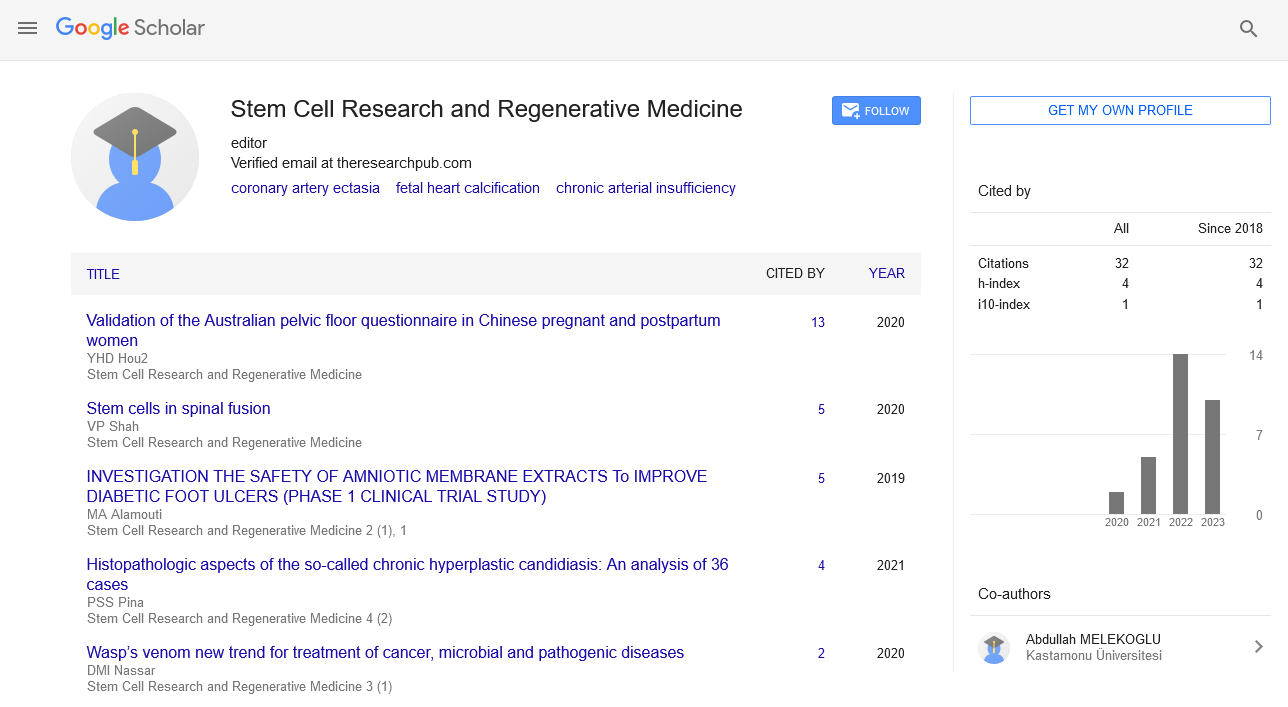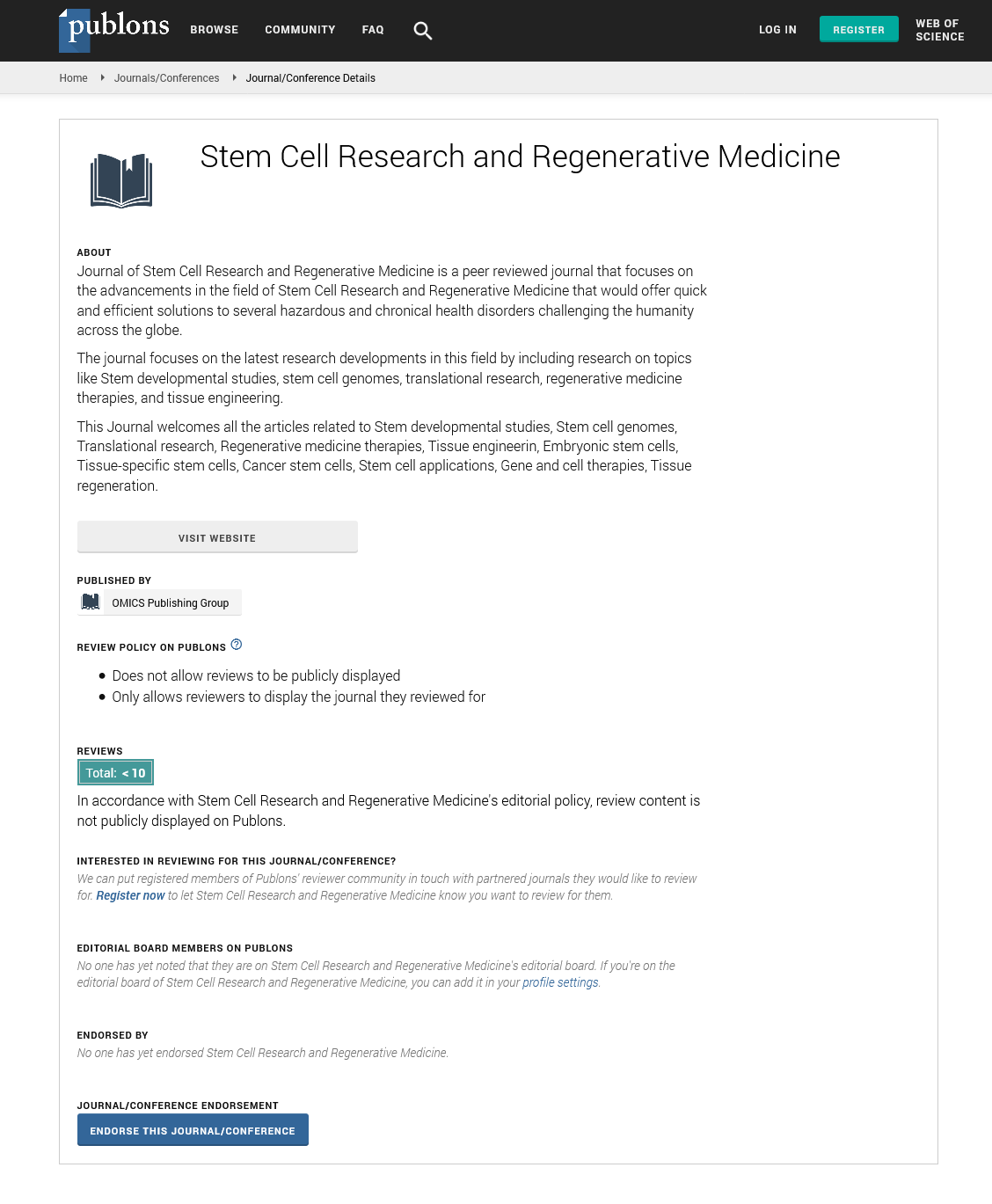Perspective - Stem Cell Research and Regenerative Medicine (2024) Volume 7, Issue 6
Targeting cancer stem cells for therapeutic intervention
Bo Liang*
- Corresponding Author:
- Bo Liang
Department of Medicine and Prevention, The National Technological University, Buenos Aires, Argentina
E-mail: boliang880@kuh.kumamoto-u.ac.jp
Received: 02-Dec-2024, Manuscript No. SRRM-24-153858; Editor assigned: 04-Dec-2024, Pre QC No. SRRM-24-153858 (PQ); Reviewed: 18-Dec-2024, QC No. SRRM-24-153858; Revised: 23-Dec-2024, Manuscript No. SRRM-24-153858 (R); Published: 31-Dec-2024, DOI: 10.37532/SRRM.2024.7(6).272-274
Introduction
Cancer Stem Cells (CSCs) have garnered significant attention in recent years as critical targets for therapeutic intervention in oncology. The concept of CSCs challenges the traditional understanding of cancer, presenting a paradigm where a small subpopulation of cells within the tumor possesses the unique capability to self-renew, differentiate, and drive tumor growth and progression. This perspective highlights the complexities and potential of targeting CSCs, reflecting on the current advances, challenges, and the future of this promising field in cancer treatment.
Description
The existence of CSCs is based on the hypothesis that not all cancer cells are equal. While the majority of tumor cells contribute to the tumor mass, only a select few, the CSCs, have the ability to initiate new tumors. This small but potent subset of cells is believed to be responsible for metastasis, resistance to chemotherapy and radiation, and, ultimately, relapse. Conventional therapies often target the bulk of the tumor cells, leading to initial tumor shrinkage but frequently fail to eradicate CSCs, allowing for recurrence and disease progression. Therefore, a shift in focus towards targeting CSCs could redefine therapeutic strategies and improve patient outcomes.
Therapeutic resistance is a hallmark of CSCs. These cells exhibit several characteristics that make them more resilient than the differentiated tumor cells, including a quiescent or slow-cycling state, increased expression of drug efflux pumps, efficient DNA repair mechanisms, and resistance to apoptosis. Such features enable CSCs to survive standard treatments, and their persistence is a major cause of treatment failure and relapse. As a result, developing therapies that can effectively target these resistant populations is paramount in the pursuit of long-term remission and potential cures for many cancers.
One promising approach involves the identification and targeting of specific markers expressed on the surface of CSCs. These markers, such as CD44, CD133, and ALDH1, have been identified in various cancers and serve as potential targets for therapy. Monoclonal antibodies and small molecules that can bind to these markers are being explored as strategies to eliminate CSCs specifically. In addition, there is interest in understanding the signaling pathways that regulate CSC behavior, including the Notch, Wnt, and Hedgehog pathways, which are often dysregulated in cancer. Inhibitors targeting these pathways are in development, aiming to disrupt the signaling networks that sustain CSC survival and self-renewal. However, the redundancy and complexity of these pathways present challenges, as CSCs can often adapt and activate alternative pathways to maintain their malignant properties.
The tumor microenvironment plays a crucial role in maintaining the stemness of CSCs. The niche surrounding CSCs, composed of immune cells, fibroblasts, extracellular matrix, and signaling molecules, creates a supportive environment that promotes CSC survival and drug resistance. Targeting the tumor microenvironment, alongside CSCs, is emerging as a complementary strategy. By disrupting the interactions between CSCs and their niche, it may be possible to render CSCs more susceptible to existing therapies. This approach is gaining traction, with clinical trials exploring agents that modify the tumor microenvironment or inhibit the signaling molecules that mediate CSC-niche communication.
Immunotherapy, particularly immune checkpoint inhibitors and CAR-T cell therapy, has revolutionized cancer treatment, and there is growing interest in integrating these strategies with CSC-targeted approaches. CSCs have been shown to evade immune surveillance through various mechanisms, including the expression of immune checkpoint molecules like PD-L1 and secretion of immunosuppressive cytokines. Therefore, combining CSC-targeted therapies with immune modulation holds promise. Strategies such as CAR-T cells engineered to target CSC-specific antigens or checkpoint inhibitors designed to enhance the immune response against CSCs are currently under investigation. The goal is to overcome the immune-evasive tactics of CSCs, thus enhancing the overall efficacy of immunotherapy in solid tumors.
Despite the promise, targeting CSCs is not without significant challenges. One of the primary obstacles is the inherent plasticity of cancer cells, where non-stem cancer cells can revert to a stem-like state under certain conditions, such as stress or exposure to cytotoxic therapies. This plasticity complicates efforts to eradicate CSCs completely, as targeting one subpopulation may not be sufficient to prevent the emergence of new CSCs. Additionally, CSCs often lack universal markers, leading to difficulties in accurately identifying and isolating them from the heterogeneous tumor cell population. This heterogeneity extends not only between different types of cancers but also within individual tumors, making it challenging to develop therapies that can effectively target all CSCs.
Furthermore, safety concerns are a critical consideration in CSC-targeted therapies. Since CSCs share many similarities with normal stem cells, such as self-renewal and differentiation capabilities, there is a risk of off-target effects that could damage normal stem cell populations, leading to unintended consequences like tissue toxicity or impaired regeneration. Therefore, a fine balance must be struck to ensure that therapies specifically target cancer stem cells while sparing normal stem cells, a task that requires precision and an in-depth understanding of the biology underlying both populations.
In recent years, the advent of advanced technologies, such as single-cell sequencing, CRISPR-Cas9 gene editing, and organoid cultures, has provided researchers with more sophisticated tools to study CSCs. Single-cell sequencing has revealed the vast heterogeneity within tumors, allowing for a more detailed analysis of CSC populations. CRISPR-Cas9 is enabling precise gene editing to knock out genes critical for CSC survival, offering a deeper understanding of their vulnerabilities. Meanwhile, organoid cultures, which mimic the three-dimensional architecture of tumors, provide a more accurate model for studying CSC behavior and testing therapeutic strategies in vitro. These technological advancements are likely to play a significant role in shaping the future of CSC research and therapeutic development.
The clinical translation of CSC-targeted therapies is still in its infancy, but the results from early-phase clinical trials are encouraging. In some cases, the combination of CSC-targeted agents with conventional therapies has shown improved outcomes, indicating that eliminating CSCs may enhance the effectiveness of standard treatments. However, the road to successful CSC-targeted therapies is long, requiring not only a deeper understanding of CSC biology but also innovative approaches to drug development, clinical trial design, and patient selection. Biomarkers to predict treatment response and identify patients who would benefit most from CSC-targeted therapies are still lacking, and developing such biomarkers is a priority for the field.
The future of cancer therapy may well depend on our ability to understand and manipulate the unique biology of CSCs. As our knowledge expands, it is becoming increasingly clear that a one-size-fits-all approach is unlikely to succeed. Precision medicine, which tailors treatment to the individual characteristics of a patient’s tumor, will be essential. In the context of CSCs, this may involve personalized strategies that target specific CSC markers, disrupt unique signaling pathways, or modulate the tumor microenvironment based on the specific CSC properties within a given tumor.
Conclusion
Targeting cancer stem cells for therapeutic intervention represents a paradigm shift in oncology. While significant challenges remain, the potential benefits of effectively targeting CSCs reduced relapse, prevention of metastasis, and longer-lasting remissions make it a goal worth pursuing. The complexities of CSC biology require a multifaceted approach, combining targeted therapies, immune modulation, microenvironment disruption, and an understanding of tumor heterogeneity. The next decade will be crucial in determining whether CSC-targeted therapies can move from experimental concepts to clinical reality, offering new hope for patients with some of the most challenging and resistant forms of cancer. As research continues, a greater emphasis on collaboration between basic scientists, clinicians, and industry will be essential to overcome the barriers that currently impede progress. The pursuit of CSC-targeted therapies underscores a larger trend in cancer treatment moving towards more precise, targeted, and individualized approaches that aim to treat not just the tumor, but the underlying mechanisms driving its persistence and spread.


